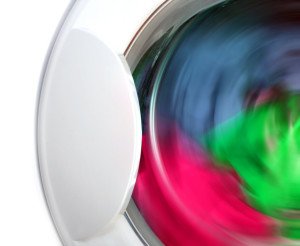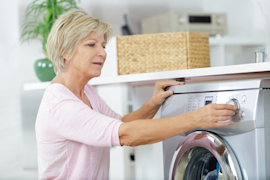Troubleshooting excessive vibration during spin cycle on a washer


There's an uncomfortable urgency to the sound of the washer banging against the dryer or walking across the laundry room floor. It's a noise that compels us to drop what we're doing and dash to the laundry room to try to calm the gyrating machine.
A variety of causes can make a washing machine vibrate excessively. Here are some that are easy to remedy without replacing any parts. If these suggestions don't bring peace to the laundry room, check out these repairs.
The washer load is unbalanced
If you loaded the washer with heavier clothes on one side, or if they shift to one side of their own volition, the load becomes unbalanced. Unbalanced loads are especially common with large or bulky items, especially if the load is small.
The solution is simple: open the washer and redistribute the load.
If you don't untangle and rearrange the soggy load, the washer adds water and swishes the clothes around in an effort to correct the problem. After a set number of tries, it gives up and stops the cycle.
The leveling legs need to be adjusted
All four leveling legs should have full contact with the floor. To check, place your hands on the corners of the empty washer and rock it slightly side to side. If the washer rocks, adjust the legs following the directions in your owner's manual.
The flooring is weak
Above-ground floor installations or pier-and-beam foundations may not offer adequate support for some washing machines, particularly washers with a high-speed spin. Securing a sheet of 3/4-inch plywood to the floor under the washer base sometimes resolves the excessive vibration.
Something in the washer is broken
The problem might be that components that stabilize the washer have broken. Possibilities include suspension springs, balance rings, snubber pads and shock absorbers. Inspect these parts and replace any that are broken.
Stabilizing components vary by model, so check your owner's manual for details about your machine.
The washer still has shipping bolts
If the washer is new or was recently moved, check to see if the shipping bolts are still in place. Shipping bolts usually are in the back of the washer, with one in each corner around the drum area. If the bolts are in place, remove them. Operating a washer with the shipping bolts in place causes extreme vibration and damages the machine.
Most common symptoms to help you fix your washers
Choose a symptom to see related washer repairs.
Main causes: broken lid switch or lid lock, bad pressure switch, broken shifter assembly, faulty control system…
Main causes: lack of electrical power, wiring failure, bad power cord, electronic control board failure, bad user interf…
Main causes: leaky water inlet valve, faulty water-level pressure switch, bad electronic control board…
Main causes: water heater failure, bad water temperature switch, faulty control board, bad water valve, faulty water tem…
Main causes: no water supply, bad water valves, water-level pressure switch failure, control system failure, bad door lo…
Main causes: worn agitator dogs, bad clutch, broken motor coupler, shifter assembly failure, broken door lock, suspensio…
Main causes: unbalanced load, loose spanner nut, worn drive block, broken shock absorber or suspension spring, debris in…
Main causes: clogged drain hose, house drain clogged, bad drain pump, water-level pressure switch failure, bad control b…
Main causes: bad lid switch or door lock, bad timer or electronic control board, wiring failure, bad water inlet valve a…
Most common repair guides to help fix your washers
Effective articles & videos to help repair your washers
Use the advice and tips in these articles and videos to get the most out of your washer.

Find tips for using your washing machine efficiently to save energy and help reduce utility bills.…

Learn about all the convenient features on our Sears PartsDirect website that make your parts purchases easier.…

Get answers to frequently asked questions about Sears and Sears PartsDirect.…
